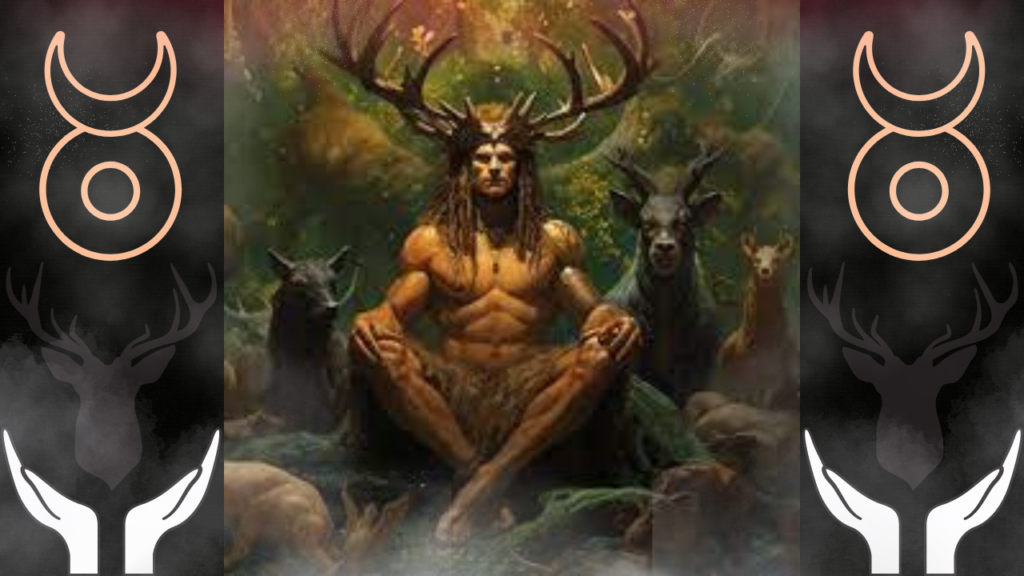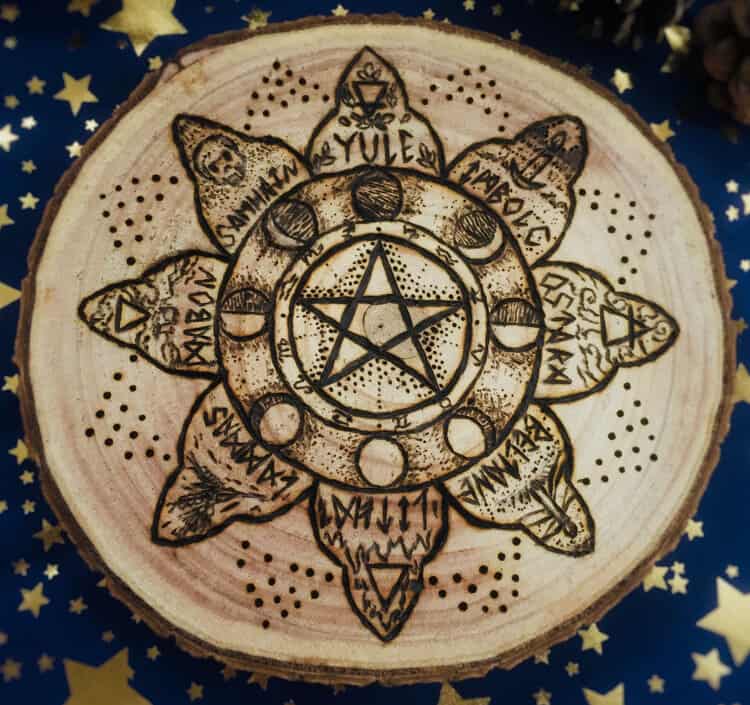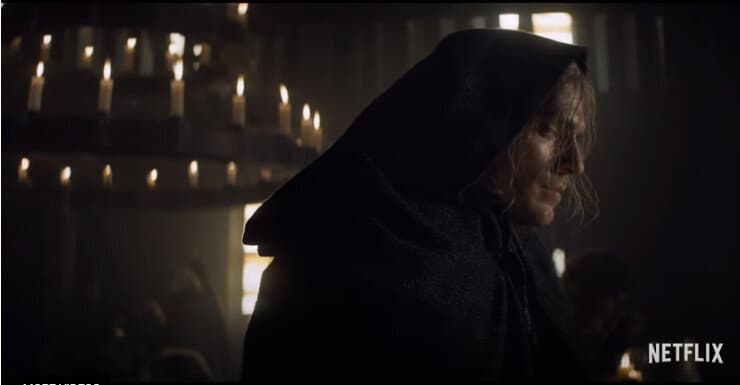In the wonderfully diverse world of pagan beliefs and practices, few figures are as enigmatic and revered as the Horned God. Often misunderstood, this deity represents the raw, unbridled forces of nature and the cycle of life, death, and rebirth. Through the perspective of a pagan witch, we shall embark on this journey to explore the depths of this ancient deity. We will be touching upon the intriguing aspects of the Oak King and Holly King and this relevance. Join me as we dive into the mysteries of the Horned God, shedding light on his significance, manifestations, and the ways in which he enriches the spiritual path of modern witchcraft.
Who Exactly Is the Horned God?
The Horned God, cloaked in the whispers of the forest and the call of the wild. He is a figure that transcends a simple categorization. Far from the often-misguided portrayals of darkness, his horns stand as a crown of natural sovereignty, connecting him intimately to the rhythms of the earth and all its creatures. This deity, with antlers that reach towards the heavens, embodies the primal essence of the wilderness, virility, and the unending dance of the seasons. He serves as the consort to the Goddess, his presence weaving through the tapestry of life and death, a reflection of the eternal cycle that nurtures and renews the earth.
In his essence, the Horned God encapsulates the duality of existence—harboring within him the seeds of creation and destruction, of birth and rebirth. His portrayal across various cultures and pagan traditions often showcases a figure that is both nurturing and fierce. He is seen as a protector of all that is wild and free. Through his connection to the stag, he navigates the forest of the spiritual realm, guiding souls and embodying the masculine principle that, when harmonized with the feminine, creates a balance fundamental to the flourishing of life.
As a deity of fertility, his influence permeates the soil, the roots, and the blooming of flowers. He invites us to recognize the sacredness in the cycles of growth and decay, in the hunt, and in the quietude of nature’s embrace. The Horned God is not merely a figure to be revered, he is an invitation to experience the boundless wonder of the natural world. He is there for us to understand our role within it and to awaken to the cycles that move within us, which echo the ancient rhythm of the earth itself.
The Significance of the Horned God in Paganism
In the realm of paganism, the Horned God emerges as a quintessential emblem of the interplay between the masculine force and the vivacious pulse of the natural world. His esteemed stature among deities is not merely a matter of reverence; it is a recognition of his role as a custodian of life’s cycles, from the silent whispers of growing seeds to the commanding presence of towering forests.
The Horned God is synonymous with the protective embrace of the wilderness, standing as a sentinel over all creatures, embodying the courage and freedom that wild spaces inspire. His domains stretch across the fertile earth, whispering through the leaves and dancing in the shadows, making him an essential figure who bridges the human experience with the more-than-human world.
This deity’s significance extends beyond his guardianship of nature’s domain. He is a vital component of the wheel of the year, his energy waxing and waning with the seasons, reflecting the perpetual dance of light and darkness. This cyclical existence illustrates the inherent balance within the fabric of life, a principle pagans hold dear. Through the stories of the Oak King and Holly King, his influence weaves a narrative of continual renewal and transformation. It teaches us the importance of embracing change and the inevitability of transitions.
In paganism, the Horned God’s narrative is a compelling invitation to align our lives with the elemental forces that govern existence. His enduring legacy is a testament to the profound connection between the divine masculine and the fertile, boundless creativity of nature, encouraging a harmonious coexistence with the earth and all its inhabitants.
The Oak King and Holly King: Faces of the Horned God
If you reach into the captivating saga of the Oak King and the Holly King, you will find two contrasting yet complementary aspects that embody the Horned God’s dominion over the changing seasons. These archetypes represent the eternal dance between light and shadow, growth and rest, showcasing the Horned God’s intricate relationship with the cycle of life.
The Oak King, sovereign of the waxing year, brings forth the vitality of spring and the exuberance of summer. His reign begins at the Winter Solstice, which is a time when the light starts to pierce the darkness, heralding a period of burgeoning life and energy. He is the breath of fresh air after a long winter, the sprouting seed, and the strength of the midday sun, symbolizing expansion, vibrancy, and the triumphant return of warmth to the land.
Conversely, the Holly King rules over the waning year, from the Summer Solstice, when the light reaches its zenith and begins to fade into the cool embrace of autumn and the reflective quiet of winter. He embodies the wisdom of the elder, the restful peace of long nights, and the preservation of life through the darker times. The Holly King’s sovereignty is a reminder of the necessity of withdrawal, of turning inward to conserve energy and prepare for rebirth.
Their perpetual struggle and eventual handover of power at the solstices are not merely battles but a harmonious exchange. This exchange symbolizes the inherent balance within nature. This cyclical narrative also highlights the Horned God’s role as a guardian of equilibrium. Always teaching us the importance of embracing the full spectrum of life’s experiences, which can vary from the vigorous heights of activity to the contemplative depths of rest.
The Horned God in Rituals and Celebrations
In the vibrant tapestry of pagan tradition, the Horned God assumes a pivotal role, particularly during rituals and celebrations that echo the ebb and flow of the natural world. His presence is palpably felt during the turning of the Wheel of the Year, where each Sabbat offers a unique opportunity to honor his influence and teachings. Beltane, with its fires of fertility and promise of new life, Samhain, a time of reflection and remembrance, both stand out as moments when the Horned God’s essence is most potent. These festivals serve as gateways to understanding the deeper mysteries of life, death, and rebirth, through which pagans engage with the Horned God’s dual aspects of protector and nurturer.
During these sacred times, rituals are crafted with care to symbolize the Horned God’s connection to the earth’s cycles. Through the lighting of fires, the casting of circles, and the chanting of ancient verses, practitioners invite his energy to empower their celebrations. These acts are not mere ceremonies but are expressions of a profound communion with the natural world, facilitated by the Horned God’s guiding hand. He is revered as the keyholder to the untamed wilderness and its boundless wisdom, offering insights into the rhythms that govern all life.
Embracing the Horned God in such celebrations allows for a deeper synchronicity with the forces of nature, weaving his vitality and vigor into the fabric of pagan practice. Through dance, song, and ritual, his spirit is invoked, enriching the spiritual journey of those who seek to walk in harmony with the earth’s ever-changing landscape.
The Horned God’s Role in Modern Witchcraft
In the practice of modern witchcraft, the Horned God occupies a central place, serving as a beacon of natural wisdom and a symbol of the intricate balance between humanity and the earth. His venerable presence is invoked in rituals and magic that seek to harness the raw energies of nature, guiding witches and practitioners in their quest for harmony and understanding. The reverence for this deity goes beyond mere tradition; it is a recognition of his enduring relevance in a world that often feels disconnected from its natural roots.
Witches today draw upon the Horned God’s aspects of protection, fertility, and transformation to navigate the challenges of contemporary life. He is a constant companion in magical workings related to personal growth, ecological stewardship, and the cyclical changes of the seasons. His lessons inspire practitioners to look deeply into the heart of nature, to find resilience in the face of adversity, and to celebrate the beauty of life in all its forms.
The Horned God’s ethos, embodying both the wild untamed aspects of the natural world and a nurturing, protective presence, encourages a path of ecological consciousness and spiritual resilience. By aligning with his energy, modern witches find a powerful ally in their efforts to craft a life that honors the sacredness of the earth, and to promote healing and balance in their communities and beyond.
His role in modern witchcraft is not just as a figure of worship but as a dynamic force that propels the community towards greater ecological awareness, personal empowerment, and a deeper, more meaningful engagement with the mysteries of the natural world. Through the lens of witchcraft, the Horned God’s ancient wisdom illuminates the path forward, guiding practitioners to live in harmony with the earth’s rhythms and cycles.
Connecting with the Horned God: A Personal Path
Embarking on the quest to forge a bond with the Horned God opens doors to untold spiritual richness and a profound connection to the pulsating heart of nature. This venture is deeply individual. It is shaped by personal beliefs, experiences, and the unique ways one interacts with the natural world to invite the Horned God into your life is to welcome his wisdom, vitality, and transformative power, as you embark on a journey that promises growth and deeper understanding of the cycles of existence.
Cultivating this connection might begin in the quiet solitude of the forest or the sacred space of your own home, where meditation and ritual serve as conduits to the divine. These practices allow for a quieting of the mind, making room for the voice of the Horned God to be heard through the rustle of leaves or the whisper of intuition. It’s in these moments of stillness that his guidance becomes clear, steering us toward harmony with the natural and spiritual realms.
Acknowledging the changing seasons and celebrating the Sabbats aligns our rhythm with that of the earth, fostering a deeper resonance with the Horned God’s cyclic nature. By observing the intricate dance of life, death, and rebirth that unfolds around us, we mirror these patterns in our spiritual practices, honoring his presence in all facets of life.
Creating a personal altar with symbols of the Horned God—antlers, oak leaves, or representations of the stag— all act as a focal point for devotion, reminding us of his enduring presence. Through these acts of reverence and connection, we weave the essence of the Horned God into our daily lives, embracing his teachings and embodying the balance and resilience he exemplifies. This journey is one of discovery, and a path that leads us to uncover the depth of our connection to the earth and the divine masculine. Connecting with the Horned God will guide you towards a life of harmony and spiritual fulfillment.











